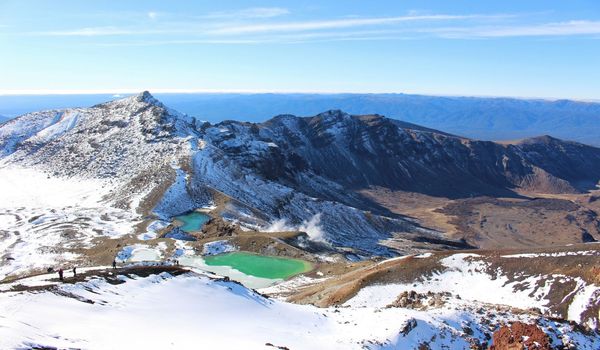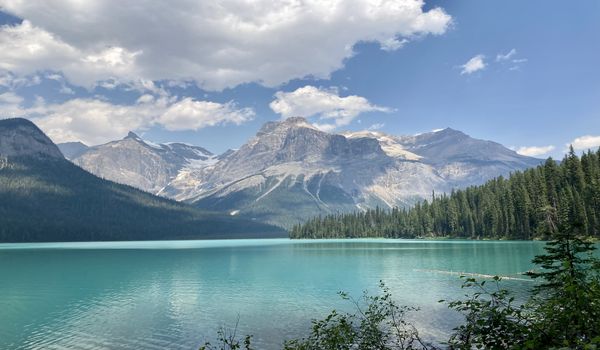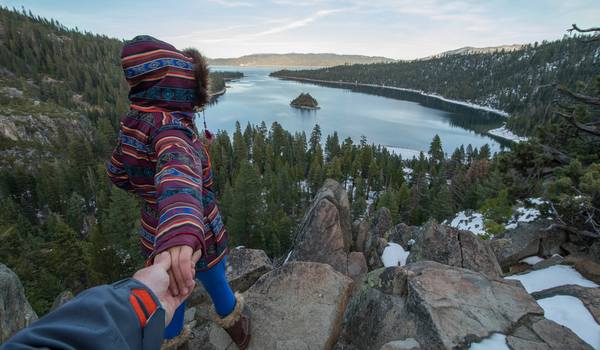🗻 Introduction to the Emerald Lake Lookout
The Tongariro Alpine Crossing is renowned for its diverse landscapes and breathtaking vistas, and one of its standout features is the Emerald Lake Lookout.
A scenic viewpoint that offers hikers a mesmerizing panorama of the emerald lakes, providing a unique and unforgettable experience in the heart of Tongariro National Park.
1. Description of the Emerald Lake Lookout
Located along the Tongariro Crossing, the Emerald Lake Lookout is strategically positioned, an awe-inspiring view of the three iconic emerald lakes—Te Wai-Whakaata-o-te-Rangihiroa (the closest to the lookout), Te Wai-a-Moe (the middle lake), and Te Wai-iti (the farthest lake).
These stunning lakes get their vivid green color from minerals and volcanic activity, creating a surreal and captivating scene against the rugged volcanic terrain.

⭐ Key Features and Highlights:
🏞 Emerald Lakes:
- The Emerald Lake Lookout provides a perfect vantage point to appreciate the lakes’ distinct emerald coloration, resulting from dissolved minerals and volcanic activity.
- Each lake has its unique shade of green, creating a visually stunning and dynamic landscape.
🌄 Panoramic Vistas:
- The lookout offers panoramic vistas of the surrounding volcanic terrain, including the nearby Red Crater, Mount Ngauruhoe (Mount Doom from “The Lord of the Rings” trilogy), and the expansive Tongariro National Park.
- Hikers can capture breathtaking photographs of the lakes against the backdrop of the rugged and picturesque landscape.
🏞️ Volcanic Terrain:
- The Emerald Lake Lookout is situated within the Tongariro Volcanic Complex, a UNESCO World Heritage site, allowing hikers to witness firsthand the geological features shaped by ancient volcanic activity.
- The terrain showcases lava flows, volcanic rocks, and other unique formations, providing a geological spectacle for enthusiasts.
🚶♂️ Hiking Experience:
- The trek to the Emerald Lake Lookout is a challenging yet rewarding part of the Tongariro Crossing. Hikers navigate through diverse landscapes, including rocky slopes and elevated terrains, adding an adventurous element to the journey.
- The lookout serves as a well-deserved rest point for hikers, allowing them to soak in the scenery and appreciate the natural wonders surrounding them.

2. Additional Information
- Trail Accessibility: The Emerald Lake Lookout is accessible during the Tongariro Crossing, a one-day trek that covers approximately 19.4 kilometers (12 miles) of diverse landscapes.
- Best Time to Visit: The summer months (November to April) offer the best weather conditions for the Tongariro Crossing. However, the weather in alpine regions can change rapidly, so it’s crucial to be prepared for varying conditions.
- Guided Tours: While hiking the Tongariro Crossing independently is possible, guided tours with experienced local guides are available. Guides provide insights into the geological features, Maori cultural significance, and safety precautions.
- Safety Considerations: Hikers should be prepared for variable weather conditions, including strong winds and sudden temperature changes. Adequate clothing, food, water, and sturdy footwear are essential for a safe and enjoyable trek.

3. Tips for Hiking the Emerald Lake
For the most accurate and up-to-date information regarding the Tongariro Alpine Crossing, we recommend checking the official website of the Department of Conservation (DOC) New Zealand or contacting their local visitor center.
However, we can provide some general advice and considerations that visitors should keep in mind when planning to do the Tongariro Alpine Crossing:
- Weather Conditions: The weather in alpine regions can change rapidly. Check the latest weather forecast before starting the hike. Be prepared for a variety of conditions, including rain, wind, and potential temperature changes.
- Trail Conditions: Check for trail closures, maintenance, or special alerts on the Tongariro Alpine Crossing. The trail may be partially closed or have restrictions due to volcanic activity, weather events, or other factors.
- Guided Tours: While hiking independently is possible, considering a guided tour can enhance your experience. Guides provide valuable insights into the geological features, cultural significance, and safety measures.
- Transportation: Plan your transportation to and from the trailhead in advance. There are shuttle services available, and parking may be limited. Consider booking transportation services to ensure a smooth trip.
- Fitness Level: The Tongariro Alpine Crossing is a challenging hike. Assess your fitness level and be prepared for a full day of hiking over varied terrain. Carry sufficient water, food, and wear appropriate clothing and footwear.
- Safety Precautions: Follow safety guidelines and respect the natural environment. Stick to designated paths, and be cautious around volcanic features. Carry a map, tell someone know about your plans, and have a charged mobile phone for emergencies.
- Volcanic Activity: Be aware of any volcanic activity alerts in the area. The Tongariro National Park is a volcanic region, and conditions can change. Check with local authorities for the latest updates on volcanic activity.
- Leave No Trace: Practice Leave No Trace principles. Carry out all waste, stay on designated trails, and avoid disturbing wildlife. Help preserve the natural beauty of the area for future generations.

4. Alternative Hikes inside and/or around the Tongariro National Park
- Taranaki Falls Walk: Enjoy a scenic walk to Taranaki Falls, a stunning 20-meter waterfall nestled in the foothills of Mount Ruapehu. The trail provides beautiful views of the volcanic landscape.
- Tama Lakes Track: Explore the Tama Lakes Track for an alternative trek within Tongariro National Park. This trail leads to the Tama Lakes, offering serene alpine scenery and a unique perspective of Mount Ngauruhoe.
- Whakapapa Village Exploration: Explore Whakapapa Village, the gateway to Tongariro National Park. Visit the Whakapapa Visitor Centre, discover local Maori culture, and take shorter walks around the village.
- Ruapehu Crater Climb: Consider the Ruapehu Crater Climb for a challenging ascent. This guided adventure takes you to the summit of Mount Ruapehu, providing breathtaking views of the surrounding landscapes.
- Silica Rapids Track: Take the Silica Rapids Track for a shorter yet rewarding hike. The trail leads to the Silica Rapids, known for their milky blue waters and surrounded by native beech forest.
- Tongariro Northern Circuit: Extend your hiking adventure with the Tongariro Northern Circuit, a multi-day trek that circumnavigates Mount Ngauruhoe and includes diverse landscapes and alpine scenery.

🧑💻 Frequently Asked Questions about The Emerald Lakes Lookout
1. Where is the Emerald Lakes Lookout located?
The Emerald Lakes Lookout is situated along the Tongariro Alpine Crossing in Tongariro National Park, New Zealand. It offers a panoramic view of the three iconic emerald lakes.
2. How challenging is the hike to the Emerald Lakes Lookout?
The hike to the Emerald Lakes Lookout is part of the Tongariro Alpine Crossing, which is considered moderately challenging. The terrain includes rocky slopes and elevated sections, making sturdy footwear and a reasonable fitness level advisable.
3. What makes the lakes appear emerald green?
The emerald green color of the lakes is attributed to minerals and volcanic activity in the area. Dissolved minerals, combined with the unique geothermal conditions, create the distinctive hues of the lakes.
4. Are there other notable features visible from the Emerald Lakes Lookout?
Yes, the lookout provides breathtaking views of the surrounding volcanic terrain, including the nearby Red Crater and the iconic Mount Ngauruhoe, also known as Mount Doom from “The Lord of the Rings.”
5. Is there a specific time of the year recommended for visiting the Emerald Lakes Lookout?
The Tongariro Alpine Crossing, including the Emerald Lakes Lookout, is most accessible during the summer months (November to April) when the weather is generally milder. However, hikers should be prepared for variable conditions.
6. Can I take guided tours to the Emerald Lakes Lookout?
Yes, guided tours are available for the Tongariro Alpine Crossing, offering insights into the geological features, cultural significance, and ensuring a safe and informative hiking experience.
7. How long does it take to reach the Emerald Lakes Lookout during the Tongariro Crossing?
The hike to the Emerald Lakes Lookout is part of the Tongariro Alpine Crossing, which typically takes about 7–8 hours to complete. The Emerald Lakes Lookout is roughly halfway along the trail.
8. Are there facilities or rest points at the Emerald Lakes Lookout?
While there may not be specific facilities at the lookout, it serves as a rest point for hikers to take in the scenery and enjoy a well-deserved break during the challenging trek.
9. Are there safety considerations for hiking to the Emerald Lakes Lookout?
Yes, hikers should be prepared for changing weather conditions, carry sufficient water and supplies, wear appropriate clothing, and be mindful of the challenging terrain. It’s advisable to check weather forecasts and follow safety guidelines.
10. Are the Emerald Lakes Lookout and Tongariro Crossing family-friendly?
The Tongariro Crossing and the Emerald Lakes Lookout can be suitable for families with older children who are accustomed to hiking. However, it’s essential to consider the trail’s difficulty and individual fitness levels.








